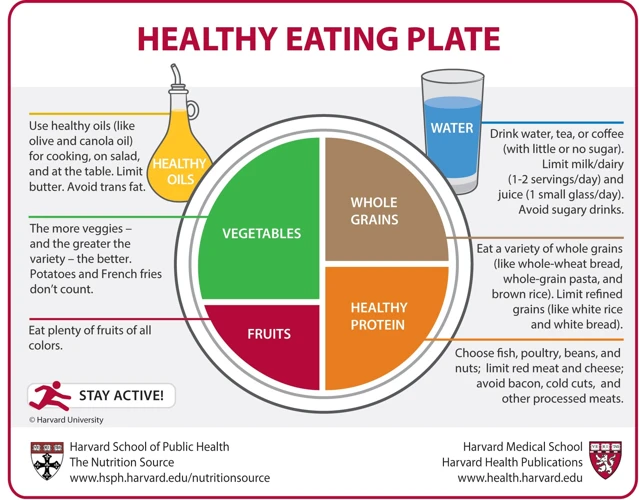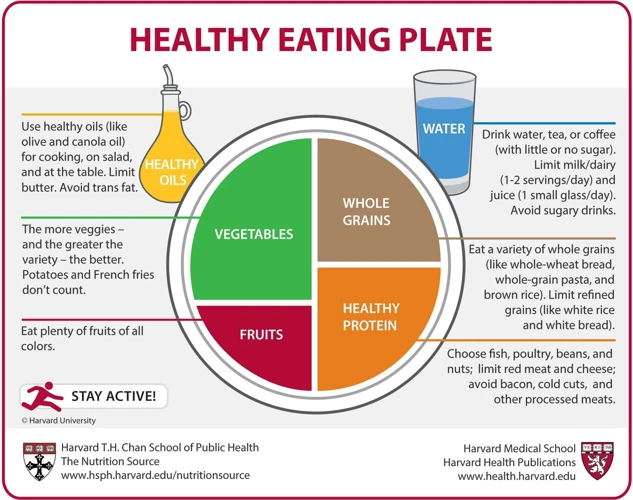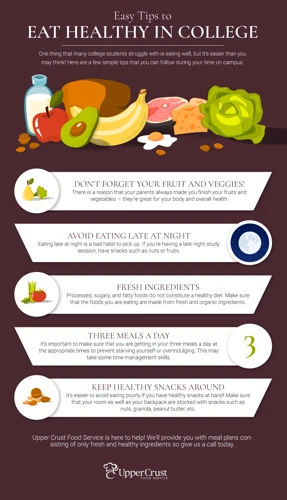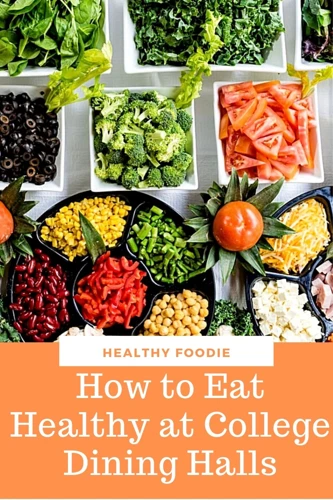As a college student, eating healthy can be a challenging task, especially when your main source of food is the dining hall. With an abundance of options that are convenient, but not always nutritious, it’s easy to be perplexed on how to make healthier choices. However, with a few smart tips, you can make the most out of your dining hall experience and keep yourself fueled with healthy foods. From choosing the right dining hall to customizing your meals, these 10 tips will help you eat healthily and stay on track with your goals while navigating the dining hall options.
Choose Your Dining Hall Wisely

When it comes to maintaining a healthy diet in college, choosing the right dining hall can make all the difference. You want to choose a dining hall that offers a variety of options, with an emphasis on nutrient-dense foods. But with so many different dining halls on campus, how do you know which one to choose? Consider the tips below to make an informed decision and eat healthy in college. And if you’re looking to save some money and eat healthy at home, check out our article on meal prepping on a budget for college students.
Consider Nutrient Diversity
Nutrient diversity is crucial in maintaining a healthy diet. Eating a variety of foods is important to ensure that your body gets all the necessary nutrients it needs to function properly. When choosing your meals at the college dining hall, it’s essential to consider the nutrients you’re consuming.
One way to achieve nutrient diversity is by incorporating a variety of colored fruits and vegetables in your meals. Each color represents different nutrients that are essential to the body. For instance, orange fruits and vegetables are high in beta-carotene, which is excellent for eye and immune health, while green leafy vegetables are high in iron and calcium.
Eating whole grains, lean proteins, and healthy fats are also important in maintaining nutrient diversity. The table below highlights essential nutrients that should be included in your meals and the foods that are rich in these nutrients.
| Nutrient | Food Source |
|---|---|
| Protein | Chicken, Fish, Tofu, Beans, Lentils |
| Calcium | Milk, Yogurt, Cheese, Leafy Greens |
| Iron | Red Meat, Beans, Spinach, Tofu |
| Vitamin C | Oranges, Strawberries, Broccoli, Tomatoes |
| Vitamin A | Carrots, Sweet Potatoes, Spinach, Cantaloupe |
| Vitamin B-12 | Eggs, Cheese, Milk, Meat |
| Omega-3 Fatty Acids | Salmon, Walnuts, Flaxseeds, Chia Seeds |
It’s essential to understand that consuming a variety of foods is crucial in obtaining a healthy and balanced diet. By incorporating different colored fruits and vegetables, protein, calcium, iron, vitamin C, vitamin A, vitamin B-12, and omega-3 fatty acids in your diet, you can ensure nutrient diversity and maintain optimal health. Don’t forget to check out some of our helpful articles on healthy snacks under $5 for college students, grocery shopping on a tight budget in college, and easy plant meals for college students for more helpful tips on maintaining a healthy diet while in college.
Look for Healthy Options
When dining in a college dining hall, it can be overwhelming to try and navigate the endless options available. However, it is important to prioritize your health and make wise food choices to ensure you are fueling your body with the necessary nutrients. Here are some tips to help you look for healthy options:
1. Choose Fresh Over Processed
When selecting your meals, opt for fresh and whole foods rather than processed options. Foods that are minimally processed have fewer additives and are higher in nutrients which can contribute to overall health and well-being.
2. Look for Lean Proteins
Protein is important for maintaining and building muscle, but not all sources of protein are created equal. Look for lean protein options such as chicken, fish, beans, and tofu instead of high-fat meats like bacon or sausage.
3. Select Whole Grain Options
Whole grains are a great source of fiber, which helps with digestion and regulating blood sugar levels. Look for whole grain bread, pasta, and rice options, and avoid refined grains such as white bread.
4. Mind Your Condiments
Condiments can add unnecessary calories, sugar, and sodium to your meals. Opt for healthier condiments like hummus, mustard, and salsa, and avoid high-fat and sugary options such as mayonnaise and ketchup.
5. Fill Up on Fruits and Vegetables
Fruits and vegetables are packed with vitamins, minerals, and fiber. Be sure to include them in your meals and try to fill half of your plate with these healthy options.
By utilizing these tips and focusing on healthy options, you can make enjoyable and nutritious choices when dining in the college cafeteria.
Plan Ahead

To make healthy choices in the college dining hall, it’s essential to plan ahead and have a strategy in place. By taking a few proactive steps, you can ensure that you make the most of your meal options, and stay on track with your healthy eating goals. Here are some helpful tips to get you started:
Check the Menu
When dining in a college dining hall, it’s important to take the time to check out the menu for the day. This will help you plan ahead and make smarter choices when it comes to your meals. Here are some steps to follow when checking the menu:
- Scan the options: Start by quickly scanning the menu to get an idea of what’s available for the day. Pay attention to any special items or promotions, as well as any healthy options that catch your eye.
- Look for keywords: Look for specific keywords that indicate a healthy dish, such as “grilled,” “steamed,” or “baked.” These preparation methods typically mean that the dish is lower in calories and fat compared to fried or sautéed options.
- Check for nutritional information: Many college dining halls will provide nutritional information for their menu items. Take advantage of this by checking the calorie count, sodium content, and macronutrient breakdown of the dishes you’re considering.
- Review allergen information: If you have any food allergies or intolerances, be sure to review the allergen information on the menu. This will help you avoid any potential health risks.
- Consider creating your own dish: If you’re not finding anything that fits your dietary needs or preferences, consider creating your own dish. Many college dining halls offer “build-your-own” options for salads, sandwiches, and stir-frys. This way, you can control exactly what goes into your meal.
By taking the time to check the menu, you can make more informed choices and ensure that you’re fueling your body properly. Remember to also consider nutrient diversity and opt for healthy options whenever possible.
Fill up on Fruits and Vegetables
When it comes to eating healthy in a college dining hall, one strategy is to fill up on fruits and vegetables. These foods are packed with essential vitamins and minerals that are important for overall health and well-being. Plus, they are often lower in calories and higher in fiber, helping you to feel fuller for longer periods of time. Here are some tips for incorporating more fruits and vegetables into your diet while dining on campus:
| Tips for filling up on Fruits and Vegetables: |
|---|
| 1. Look for a salad bar or fresh fruit station. These areas typically have a variety of colorful options to choose from. Load up your plate with a variety of greens, carrots, peppers, cucumbers, and other tasty options. |
| 2. Consider a veggie dish as a main course. Some dining halls offer vegetarian or vegan options that are rich in flavor and nutrients. Choose options like veggie stir-fry or a roasted vegetable medley. |
| 3. Opt for a side of veggies instead of fries or chips. Many dining halls have steamed or roasted vegetables available as a side option. Choose these instead of higher calorie options that are often fried or loaded with unhealthy ingredients. |
| 4. Add veggies to your favorite dishes. If you’re grabbing a slice of pizza, add some mushrooms, peppers, and spinach to increase your veggie intake. If you’re having a sandwich, load it up with lettuce, tomato, and other greens. |
| 5. Try new fruits and veggies. Dining halls often have seasonal options available. Don’t be afraid to try something new, like roasted Brussels sprouts or a tropical fruit salad. |
By following these tips, you can make sure you are getting the nutrients your body needs and staying on track with your healthy eating goals. Remember, filling up on fruits and vegetables doesn’t have to be boring or difficult. With a little creativity and some experimentation, you can find delicious ways to incorporate these foods into your college diet.
Portion Control

Maintaining a balanced diet can be a challenge when faced with endless choices in a college dining hall. It’s easy to fall victim to the temptation of loading up your plate with oversized portions. However, it’s important to keep in mind that portion control plays a significant role in maintaining a healthy diet. By using smaller plates and practicing mindful eating habits, you can help regulate your portions and reduce overeating, ultimately contributing to a healthier lifestyle. Let’s explore some effective tips for incorporating portion control into your college dining hall routine.
Use Smaller Plates
When it comes to portion control, one simple trick is to use smaller plates. Research has shown that people tend to eat more when they have larger plates, as they tend to fill their plates to the brim. By using smaller plates, you can trick your brain into thinking that you are eating more than you actually are.
Here are some tips for using smaller plates:
- Choose a plate that is no larger than 9 inches in diameter.
- Fill half of your plate with vegetables and fruits.
- Use the remaining half of your plate for whole grains and lean proteins.
- Avoid piling food high on your plate.
- Eat slowly and savor each bite.
Remember, using a smaller plate doesn’t mean you have to skimp on the amount of food you eat. It just means you need to be mindful of your portions and choose nutrient-dense foods that will keep you satisfied for longer. By using smaller plates, you can make a simple change that can have a big impact on your overall health and well-being.
Avoid Overloading Your Plate
When it comes to eating healthy in a college dining hall, portion control is key. One common mistake that many students make is overloading their plate with too much food. This can lead to overeating and unnecessary weight gain.
To avoid overloading your plate, follow these tips:
- Start with small portions: Consider using a smaller plate and only taking a small amount of each dish to start. You can always go back for seconds if you’re still hungry.
- Choose nutrient-dense foods: Focus on filling your plate with fruits, vegetables, lean proteins, and whole grains instead of high-calorie, low-nutrient options.
- Avoid piling on toppings and sauces: These can add up quickly in terms of calories and fat. Instead, use them sparingly or opt for healthier alternatives like mustard or vinegar-based dressings.
- Listen to your body: Pay attention to your hunger cues and stop eating when you feel satisfied. Don’t feel pressured to finish everything on your plate.
By being mindful of your portions and making smart food choices, you can enjoy the variety of options available in your college dining hall without compromising your health.
Mindful Eating
Developing mindful eating habits can help you make healthier food choices while also promoting a more positive relationship with food. Rather than rushing through your meals or eating while distracted, try to slow down and focus your attention on your food. Here are some tips for practicing mindful eating in your college dining hall:
- Sit down to eat: Instead of grabbing food on-the-go, find a seat in the dining hall and make eating a separate activity.
- Take time to enjoy your food: Eat slowly and savor each bite, paying attention to the flavors and textures.
- Listen to your body: Before reaching for seconds or dessert, take a moment to check in with your body and assess if you’re actually still hungry.
- Notice your hunger cues: Are you eating because you’re truly hungry, or because you’re bored or stressed? Pay attention to your hunger and fullness levels throughout your meal.
- Avoid distractions: Put away your phone and resist the urge to check social media while you eat. Being present in the moment can help you make more mindful food choices.
- Practice gratitude: Take a moment to appreciate the food you’re eating and where it came from. This can help foster a more positive relationship with food.
By practicing mindful eating habits, you can become more attuned to your body’s hunger and fullness cues, make healthier food choices, and enjoy your meals more fully.
Hydration is Key

Proper hydration is essential for maintaining good health, especially when it comes to eating healthy in a college dining hall. It can be tempting to reach for sugary drinks or caffeinated beverages to stay alert during long study sessions, but these options can be dehydrating and provide little nutritional value. To make the most of your meals on campus, it’s important to prioritize hydration and make smart choices when it comes to the beverages you consume. Let’s explore some tips for staying hydrated and healthy in the college dining hall.
Opt for Water
When it comes to choosing a beverage at the college dining hall, water is the best choice for staying hydrated and healthy. Here are a few reasons why:
- Calorie-free: Unlike sugary drinks, water has no calories.
- Hydrating: Our bodies need water to function properly, and staying hydrated can improve concentration and energy levels.
- Budget-friendly: Water is often available for free at the dining hall, making it an affordable beverage option.
- Customizable: If you find plain water boring, try adding a slice of lemon or lime for a burst of flavor.
While it may be tempting to reach for sugary drinks like soda or sports drinks, they can be filled with unnecessary calories and can dehydrate you in the long run. Staying hydrated with water is a simple and effective way to support your overall health and wellness while navigating the challenges of college dining.
Avoid Sugary Drinks
When it comes to staying hydrated, it’s important to avoid sugary drinks. These drinks can add a significant amount of calories and sugar to your diet without offering much nutritional value. Here are some tips for avoiding sugary drinks in the college dining hall:
- Opt for water: Drinking water is the best way to stay hydrated without consuming any additional sugar or calories. If you don’t like the taste of plain water, try adding fruit slices or a splash of juice for flavor.
- Choose unsweetened drinks: Look for unsweetened iced tea or coffee, or opt for milk or plant-based milk alternatives like soy or almond milk.
- Avoid soda: Soda is one of the biggest culprits when it comes to added sugar. One 12 oz. can of soda can contain up to 39 grams of sugar, which is almost 10 teaspoons worth. Instead of reaching for a soda, try sparkling water or seltzer with a splash of juice for flavor.
- Read labels: Be mindful of the sugar content in sports drinks, juice, and other flavored beverages. Some can contain just as much sugar as soda.
By avoiding sugary drinks, you can cut down on your daily intake of added sugar and empty calories. Remember to stay hydrated throughout the day by drinking water and other unsweetened beverages instead.
Balance Your Plate

Maintaining a balanced diet is essential to stay healthy, especially when you’re dining in a college dining hall. Choosing the right food items in the right proportions is critical. To achieve the optimal balance, you need to fill half of your plate with fruits and vegetables, select whole grains, and lean proteins. In this section, we’ll discuss some tips on how to balance your plate and make healthier choices while dining in college dining halls.
Fill Half Your Plate with Vegetables and Fruits
One of the most essential tips for eating healthy in a college dining hall is to fill half of your plate with vegetables and fruits, which are packed with vitamins, minerals, and other essential nutrients that are crucial for maintaining good health. Here are some ways to incorporate more vegetables and fruits into your meals:
- Make a salad: Start with a bed of leafy greens, such as spinach or kale, and add a mix of colorful veggies like sliced bell peppers, cucumbers, and cherry tomatoes. Top it off with some fruit, like sliced strawberries, for a touch of sweetness.
- Choose a vegetable-based entree: Look for dishes that feature vegetables as the main ingredient, such as stir-fries or veggie burgers. These meals are not only nutritious but also filling and satisfying.
- Try roasted vegetables: Roasting vegetables enhances their natural sweetness and adds a crispy texture. Some delicious options to try include roasted sweet potatoes, Brussels sprouts, and broccoli.
- Snack on fruits: Instead of reaching for candy or chips, grab a piece of fruit like an apple or banana. Fruits are a great source of fiber and natural sugars that provide a quick burst of energy.
- Blend veggies into smoothies: Sneak in some greens, like spinach or kale, into your morning smoothie for a nutritious and energizing breakfast option.
By filling your plate with a variety of veggies and fruits, you’ll not only ensure that you’re getting the proper nutrition that your body needs but also make your meals more colorful, flavorful, and satisfying.
Choose Whole Grains and Lean Proteins
When it comes to eating healthy in a college dining hall, it’s important to choose whole grains and lean proteins. Whole grains provide more nutrients and fiber compared to refined grains, while lean proteins are a great source of essential amino acids for muscle growth and repair. Here are some tips for incorporating whole grains and lean proteins into your meals:
- Choose whole grain breads and cereals: Look for bread and cereals that list whole grains as the first ingredient. Whole grain options include whole wheat, oats, and quinoa. Skip the sugary cereals and opt for unsweetened options like plain oatmeal or whole grain cereal topped with fresh fruit.
- Pick beans and legumes: Vegetarian options like beans and legumes are great sources of protein and fiber. Try adding chickpeas to a salad or enjoying a black bean burrito.
- Choose lean protein sources: Opt for lean proteins like grilled chicken, fish, tofu, or tempeh. Avoid fried or processed proteins like chicken nuggets or deli meats.
- Choose whole grain pasta and rice: When choosing pasta or rice, opt for the whole grain variety. This will provide more nutrients and fiber compared to refined pasta or rice. Enjoy a vegetable stir-fry with brown rice or a whole wheat pasta salad with plenty of veggies.
Incorporating whole grains and lean proteins into your diet can not only provide you with more nutrients and fiber, but also keep you feeling full and satisfied for longer periods of time. Don’t be afraid to try new options and experiment with different combinations of grains and proteins.
Don’t Skip Meals

Maintaining a healthy diet in a college dining hall can be challenging, especially when you’re tempted to skip meals to save time or calories. However, skipping meals can actually lead to overeating later on and can negatively impact your energy levels and overall health. It’s important to make time for breakfast, lunch, and dinner, as well as healthy snacks throughout the day. Here are some tips to help you stay on track and avoid skipping meals.
Have a Healthy Breakfast
Starting your day with a healthy breakfast is crucial for sustained energy levels and focus throughout the day. Here are some tips for making the most of your breakfast in the college dining hall:
| Tip: | Opt for whole grains. |
| Why it’s important: | Whole grains provide sustained energy and fiber, which promotes feelings of fullness. |
| Examples: | Oatmeal, whole grain toast, quinoa. |
| Tip: | Incorporate protein. |
| Why it’s important: | Protein promotes fullness and helps maintain muscle mass. |
| Examples: | Eggs, Greek yogurt, cottage cheese, nuts and seeds, nut butter. |
| Tip: | Include fruits or vegetables. |
| Why it’s important: | Fruits and vegetables provide important vitamins and minerals for overall health. |
| Examples: | Fresh fruit, berries, avocado, spinach. |
By incorporating these three components into your breakfast, you will have a well-rounded and satisfying meal to start your day on the right foot.
Snack Smarter
When it comes to eating healthy in a college dining hall, snacking can be a challenge. It’s easy to grab a bag of chips or a candy bar from the vending machine, but these options are often loaded with sugars and unhealthy fats. Instead, choose smarter snack options to keep your energy levels up throughout the day without compromising your health.
Here are some tips for snacking smart:
| Snack | Why it’s a good choice |
|---|---|
| Apple slices with almond butter | Apples are high in fiber and vitamins while almond butter provides protein and healthy fats, making this a filling and nutritious snack. |
| Carrots and hummus | Carrots are low in calories and high in fiber, while hummus is a good source of protein and healthy fats. Together, they make a satisfying and nutritious snack. |
| Yogurt with berries and granola | Yogurt is a good source of protein and calcium, while berries offer antioxidants and fiber. Adding a small amount of granola provides extra crunch and healthy fats. |
| Nuts and dried fruit | Nuts are high in healthy fats and protein, while dried fruit offers natural sugars and fiber. A small handful of these two together is a satisfying and nutrient-dense snack. |
Remember to read nutrition labels and be mindful of serving sizes. Some packaged snacks may appear healthy but are actually high in calories, sugars, and unhealthy fats. Snacking smart is about choosing whole, nutrient-dense foods that will give you sustained energy and keep you feeling full between meals.
Watch Out for Hidden Calories

Maintaining a healthy diet can be challenging, especially when dining in a college dining hall. While some foods may appear to be healthy choices, they may have hidden calories that can impact your overall health goals. It’s essential to be mindful of the food you choose and the way it’s prepared. In this section, we’ll explore some strategies for watching out for these hidden calories, and ways to keep them out of your diet without sacrificing flavor.
Avoid Fried Foods
When it comes to eating healthy in a college dining hall, one thing you should try to avoid is fried foods. While they may be tasty, they are often high in calories, unhealthy fats, and sodium. Here are some tips to help you steer clear of fried foods:
- Choose Grilled or Baked Options: When possible, opt for grilled or baked dishes instead of fried ones. Look for grilled chicken, baked fish, or roasted vegetables instead of fried chicken tenders or french fries.
- Read the Menu Descriptions Carefully: Sometimes even dishes that sound healthy can be fried. Look for keywords like “crispy,” “deep-fried,” or “battered” on the menu and avoid those items.
- Ask for Modifications: If a dish sounds good but is fried, consider asking if it can be grilled or baked instead. Many dining halls are willing to make modifications for students with dietary preferences or restrictions.
- Use Condiments in Moderation: Condiments like ketchup and mayonnaise can be high in calories and sodium. If you do choose a fried dish, use condiments sparingly to keep your overall calorie and sodium intake in check.
By avoiding fried foods in the dining hall, you can make healthier choices that will benefit your overall health and well-being. Remember to read the menu carefully, choose grilled or baked options when possible, and use condiments in moderation. With these tips in mind, you can enjoy a nutritious and satisfying meal in the college dining hall.
Pass on the Desserts
When it comes to desserts in the college dining hall, it can be tempting to indulge in the sweet treats available. However, it’s important to remember that desserts are often high in calories, sugar, and fat. It’s better to pass on the desserts or at least limit your intake. Here are some tips to help you resist the temptation of desserts:
- Choose fruit: Instead of reaching for a slice of cake or a cookie, opt for a piece of fresh fruit. Fruits are naturally sweet and provide essential vitamins and nutrients.
- Share with a friend: If you really want to try a dessert, consider sharing it with a friend. This way, you can still enjoy a taste without overindulging.
- Take a walk: Sometimes, a change of scenery can help take your mind off of dessert. Take a walk around campus or outside for a few minutes to clear your head and resist temptation.
- Find healthier options: Some dining halls may have healthier dessert options available, such as fresh yogurt or low-fat pudding. Look for these options instead of the more decadent treats.
Remember, it’s okay to indulge in a treat every now and then. However, it’s important to make sure that your overall diet is well-balanced and includes plenty of fruits, vegetables, whole grains, and lean proteins. By limiting your intake of desserts and choosing healthier options, you can ensure that you’re on the right track to eating healthily in college.
Cook Your Own Meals

For those who want even more control over their food choices, there’s an option that can be overlooked in college dining halls: cooking your own meals. Utilizing the kitchenette and meal prepping may seem daunting at first, but it can ultimately result in a healthier and more satisfying diet. With a little planning and effort, cooking your own meals can provide a delicious and nutritious alternative to the sometimes limited options available in the dining hall.
Utilize the Kitchenette
When it comes to eating healthy in a college dining hall, utilizing the kitchenette can be a great option. This allows you to have more control over the ingredients and preparation methods of your food. Here are some tips for utilizing the kitchenette:
| Tip | Description |
|---|---|
| 1. Bring Your Own Ingredients | If the dining hall allows it, consider bringing your own ingredients such as veggies, lean proteins, and whole grains. This will allow you to easily incorporate more nutritious options into your meals. |
| 2. Use the Microwave | The microwave can be a useful tool for cooking healthy meals in the kitchenette. Try making oatmeal with added nuts and fruit for breakfast or steaming veggies for a side dish. |
| 3. Make Easy Meals | Keep it simple by making easy meals like scrambled eggs with veggies or a stir-fry with rice and protein. This will allow you to control the ingredients and make a balanced, nutritious meal. |
| 4. Stock Up on Healthy Snacks | Keep healthy snacks like fruit, yogurt, and nuts in the kitchenette for when you need a quick and nutritious snack. |
By utilizing the kitchenette, you can have more control over the ingredients in your meals, which can lead to healthier choices. Don’t be afraid to get creative and experiment with different ingredients to make delicious and healthy meals.
Meal Prep
One great way to ensure that you are eating healthy in your college dining hall is to engage in meal prep. This involves preparing your meals in advance, so that you have healthy options available to you throughout the week. Here are some tips for successful meal prep:
- Choose recipes wisely: Look for recipes that are easy to prepare and can be stored for several days without losing their flavor or texture. Legumes, whole grains, and roasted vegetables are great options because they can be easily reheated and are packed with nutritious ingredients.
- Shop smart: Be sure to buy fresh, whole foods that will last throughout the week. Plan out your meals and make a list of the ingredients that you will need. Consider buying in bulk to save money.
- Batch cook: Making large batches of meals at once can save you time and ensure that you always have a healthy option available. Divide the food into individual portions and store in the refrigerator or freezer for easy access.
- Invest in quality containers: Be sure to store your prepped meals in airtight containers that are easy to transport. Glass containers are great because they are eco-friendly and can be reheated.
- Label and date everything: Make sure to label your containers with the date and contents so that you can keep track of what you have and when it was made. This can also help you plan out your meals for the week.
By engaging in meal prep, you will have healthy options available to you even on your busiest days. This can also help you save money and reduce food waste. With some planning and organization, you can make eating healthy in your college dining hall much easier.
Don’t be Afraid to Customize
When it comes to eating healthy in a college dining hall, customization can be your best friend. While some dining halls may not have exactly what you’re looking for, don’t let that discourage you. Instead, be open to making adjustments and substitutions to create a meal that fits your nutritional goals and preferences. By taking a little extra time to customize your meals, you’ll be able to make healthier choices and feel more satisfied with your dining hall experience. Here are some tips for customizing your meals in a college dining hall.
Ask for Your Dish to be Made to Order
One great way to ensure that you’re eating healthy in a college dining hall is to ask for your dish to be made to order. This means that you can customize your meal to meet your specific dietary needs and preferences. Here are some tips to keep in mind when making your order:
- Be specific: Let the chef know exactly what you want and don’t want in your dish. For example, you can ask for less oil, no cheese, or more vegetables.
- Choose healthy cooking methods: Request that your dish be grilled, steamed, or baked instead of fried.
- Ask about portion sizes: If you’re trying to watch your calorie intake, you can request a smaller portion size.
- Inquire about ingredients: If you have allergies or intolerances, ask about the ingredients in the dish so that you can avoid any potential issues.
- Be polite: Remember to always be polite and courteous when making your request. The chef is more likely to accommodate your needs if you ask nicely.
By asking for your dish to be made to order, you can take control of your dining hall experience and ensure that you’re making healthy choices. Don’t be afraid to speak up and ask for what you need – it’s your health and well-being that is at stake.
Make Substitutions
When dining in a college cafeteria, don’t be afraid to make substitutions to customize your meal to meet your dietary needs. Here are a few tips for making substitutions:
1. Swap out unhealthy sides: If your meal comes with a side of fries or chips, ask if you can substitute it for a side of steamed veggies or a side salad. This simple substitution can significantly increase the nutrient content of your meal and help you stay on track with your healthy eating goals.
2. Choose healthier protein options: When selecting your protein, opt for leaner sources such as chicken, fish or tofu. If the dining hall offers fried or breaded options, ask if the chefs can grill or bake it instead. You’ll still get the flavor and protein you need, but in a healthier form.
3. Pick whole grains: If your meal comes with bread or pasta, try to choose whole grain options. These will be higher in fiber and can help keep you fuller for longer. If whole grain options aren’t available, you could ask for a side of brown rice or quinoa instead.
4. Avoid sauces and dressings: Many sauces and dressings can be high in calories, so it’s worth asking if there are any low-fat or low-calorie options available. Alternatively, use lemon juice or balsamic vinegar as a healthier dressing option.
5. Customize your sandwich: If you’re ordering a sandwich, ask for whole grain bread and skip the cheese and mayonnaise. Instead, ask for avocado or hummus for a healthier spread. Load up your sandwich with plenty of veggies for added nutrients and fiber.
By making these simple substitutions, you can help ensure that your cafeteria meals are healthier and better suited to meet your individual dietary needs.
Conclusion
In conclusion, maintaining a healthy diet in college is essential for both physical and mental well-being. With a few simple tips and tricks, it is possible to make healthy choices even in a college dining hall. By choosing a dining hall that offers diverse nutrient options and healthy choices, planning meals ahead of time, controlling portion sizes, staying hydrated, balancing plates with fruits, vegetables, whole grains, and lean proteins, avoiding hidden calories, cooking own meals, customizing dishes, and not skipping meals, students can ensure a healthy and productive college life.
It may not always be possible to make the healthiest choices, especially with friends and social events in the mix, but it’s important to remember that it’s all about balance. A healthy diet is not about deprivation, but rather moderation and mindful eating. With the right mindset and a little bit of effort, college students can enjoy delicious and nutritious meals while staying on track towards a healthy and happy lifestyle. So choose wisely, plan ahead, stay hydrated, balance plates, watch out for hidden calories, cook own meals, and don’t be afraid to customize your dishes – your body will thank you for it.
Frequently Asked Questions
What if my college dining hall doesn’t offer many healthy options?
You can try talking to the dining hall manager or chef to suggest healthier options or request certain changes.
How can I make sure I’m getting enough protein in my meals?
Choose lean sources of protein like grilled chicken or fish, tofu, or legumes. You can also add protein-rich toppings like nuts or seeds to your salads or oatmeal.
What are some healthy snack options I can grab on-the-go?
Fruit like apples or bananas, trail mix or nuts, and yogurt or string cheese are all great options.
Can I still enjoy a dessert in the dining hall?
You can indulge in moderation, but try to choose healthier options like fruit-based desserts or a small serving of a baked good rather than fried or heavily processed desserts.
What if I have dietary restrictions or allergies?
Most college dining halls should have options available for those with dietary restrictions or allergies. Don’t be afraid to ask for assistance or speak to the dining hall staff for options.
What’s the best way to stay hydrated while eating in a dining hall?
Drink plenty of water throughout the day and avoid sugary drinks like soda or juice. You can also add slices of fruit or herbs like mint to your water for added flavor.
How can I make sure I’m not overeating?
Use smaller plates and pay attention to portion sizes. Fill half your plate with vegetables and don’t overload on high-calorie or high-fat options.
What if I don’t have time to cook my own meals?
Plan ahead and meal prep for the week. You can also utilize the kitchenette in your dorm or apartment for quick and easy meals.
What if I have a busy schedule and can’t eat every meal in the dining hall?
Try to have healthy snacks on hand and make time for a balanced breakfast. You can also pack a lunch or pack a to-go box from the dining hall for later.
What if I’m struggling with maintaining a healthy diet in college?
Consider speaking to a nutritionist or dietitian for personalized advice and support. Your college may also have resources available for healthy eating and lifestyle choices.







